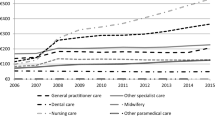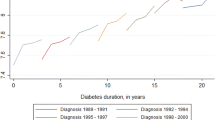Abstract
Treatment costs for type 2 diabetes account for a substantial amount of the expenses for statutory health care funds. Within a study sample of the year 2005, 6.8 % of the insured were being treated for type 2 diabetes mellitus. Compared to the non-diabetic insured in the sample, patients included more males and older persons. Employed diabetics also showed lower mean gross salary when compared to the non-diabetic employed of the sample. In 2007, their mean costs for in- and outpatient care and drug prescriptions amounted to 2,622 Euros per patient. The impacts of social and demographical patient characteristics on total treatment costs were measured with a multiple linear regression model, controlling for the hypoglycemic therapy of the patient. Here, the impact of age, gender and intensive insulin therapy became evident. A higher annual salary had a negative, yet non-significant, effect.
Similar content being viewed by others
References
Köster, I., von Ferber, L., Ihle, P., et al.: The cost burden of diabetes mellitus: the evidence from Germany—the CoDiM Study. Diabetologia 49, 1498–1504 (2006)
Lindner, T.H., Wanner, C.: Typ-2-Diabetes-mellitus—eine durch die Umwelt modifizierbare Erbkrankheit. In: Meinertz, T., Rösen, P., Ziegler, D. (eds.) Diabetes und Herz, pp. 75–97. Steinkopff, Darmstadt (2005)
UK Prospective Diabetes Study: UKPDS) Group: intensive blood-glucose control with sulphonylureas or insulin compared with conventional treatment and risk of complications in patients with type-2 diabetes (UKPDS 33. Lancet 352, 837–853 (1998)
Shichiri, M., Kishikawa, H., Ohkubo, Y., Wake, N.: Long-term results of the Kumamoto Study on optimal diabetes control in type 2 diabetic patients. Diabetes Care 23(Suppl. 2), 1–29 (2000)
Gaede, P., Vedel, P., Larsen, N., et al.: Multifactorial intervention and cardiovascular disease in patients with type 2 diabetes. N. Engl. J. Med. 348, 383–393 (2003)
Abraira, C., Duckworth, W.C., Moritz, T.: Glycaemic separation and risk factor control in the veterans affairs diabetes trial: an interim report. Diabetes Obes. Metab. 11, 150–156 (2009)
Ott, P., Benke, I., Stelzer, J., et al.: “Diabetes in Germany” (DIG) Studie. Dtsch. Med. Wochenschr. 134, 291–297 (2009)
Scanlan, M.C., Blond, L.: Adherence to practice guidelines for people with diabetes mellitus. In: Feinglos, M.N., Bethel, M.A. (eds.) Type 2 diabetes mellitus, pp. 235–249. Humana, Totowa (2008)
Vogel, H., Kulzer, B.: Patientenschulung bei Diabetes mellitus. In: Petermann, F., Lecheler, J. (eds.) Patientenschulung, pp. 59–78. Dustri, Munich (1992)
Kulzer, B., Albus, C., Herpertz, S., et al.: Psychosoziales und Diabetes mellitus. Diabet 3(Suppl. 2), 168–174 (2008)
Geyer, S.: Die Bestimmung der sozioökomischen Position in Prozessdaten und ihre Verwendung in Sekundärdatenanalysen. In: Swart, E., Ihle, P. (eds.) Routinedaten im Gesundheitswesen, pp. 203–213. Verlag Hans Huber, Bern (2005)
Mielck, A.: Soziale Ungleichheit und Gesundheit. Verlag Hans Huber, Bern (2005)
BMGS P25: GKV-Statistik KM6. http://www.bmg.bund.de/cln_160/nn_1168248/SharedDocs/Downloads/DE/Statistiken/Gesetzliche-Krankenversicherung/Mitglieder-und-Versicherte/2005-km6-lang-pdf.html (2005). Accessed 30 June 2009
Statistisches Bundesamt: Pressemitteilung Nr. 458 vom 14.11.2007. http://www.destatis.de/jetspeed/portal/cms/Sites/destatis/Internet/DE/Presse/pm/2007/11/PD07__458__231,templateId=renderPrint.psml (2007). Accessed 18 Jan 2011
Federal Council of Germany: Verordnung über maßgebende Rechengrößen der Sozialversicherung für 2005, Drucksache 784/04. Bundesanzeiger, Köln (2004)
Von Ferber, L., Köster, I., Hauner, H.: Medical costs of diabetic complications, total costs and excess costs by age and type of treatment, results of the German CoDIM Study. Exp. Clin. Endocrinol. Diabetes 115, 97–104 (2007)
German Institute for Medical Documentation (DIMDI): ICD-10-GM. Videel, Cologne (2010)
Fricke, G., Günther, J., Zawinell, A.: ATC-Index mit DDD-Angaben für den deutschen Arzneimittelmarkt. WIdO, Bonn (2007)
Matthaei, S., Bierwirth, R., Fritsche, A., et al.: Medikamentöse antihyperglykämische Therapie des Diabetes mellitus Typ 2. Diabetes. Stoffwechse. 4, 32–64 (2009)
Giersiepen, K., Pohlabeln, H., Egidi, G., et al.: Die ICD-Kodierqualität für Diagnosen in der ambulanten Versorgung. Bundesgesundheitsbl. Gesundheitsforsch. Gesundheitsschutz 50, 1028–1038 (2007)
Hauner, H., Köster, I., Von Ferber, L.: Prävalenz des Diabetes mellitus in Deutschland 1998–2001. Dtsch. Med. Wochenschr. 128, 2632–2638 (2003)
Shaw, J.E., Sicree, R.A., Zimmet, P.Z.: Global estimates of the prevalence of diabetes for 2010 and 2030. Diabetes Res. Clin. Pract. 87, 4–14 (2010)
Stock, S.A., Redaelli, M., Wendland, G., et al.: Diabetes prevalence and the costs of illness in Germany: a study evaluating statutory health insurance in Germany. Diabet. Med. 23, 299–305 (2005)
Helmert, U., Janka, H.U., Strube, H.: Epidemiologische Befunde zur Häufigkeit des Diabetes mellitus in der Bundesrepublik Deutschland 1984 bis 1991. Diabetes. Stoffwechse. 3(271–277), 429–433 (1994)
Hauner, H.: Verbreitung des Diabetes mellitus in Deutschland. Dtsch. Med. Wochenschr. 123(24), 777–782 (2008)
Krishnan, S., Cozier, Y., Rosenberg, L., et al.: Socioeconomic status and incidence of type 2 diabetes: results from the Black Women’s Health Study. Am. J. Epidemiol. (2010). doi:10.1093/aje/kwp443
Robbins, J.M., Vaccarino, V., Zhang, H., et al.: Socioeconomic status and type 2 diabetes in African American and non-Hispanic white women and men: evidence from the Third National Health and Nutrition Examination Survey. Am. J. Public Health 91(1), 76–83 (2001)
Rathmann, W., Haastert, B., Icks, A., et al.: Health inequalities, sex differences in the associations of socioeconomic status with undiagnosed diabetes mellitus and impaired glucose tolerance in the elderly population, the KORA Survey 2000. Eur. J. Public Health 15(6), 627–633 (2005)
Robert Koch Institut: Gesundheit in Deutschland. Statistisches Bundesamt, Berlin (2006)
Geyer, S., Hemström, Ö., Peter, R., et al.: Education, income and occupational class cannot be used interchangeably in social epidemiology. Empirical evidence against a common practice. J.Epidemiol.Commun. Health (JECH) 60, 804–810 (2006)
Author information
Authors and Affiliations
Corresponding author
Rights and permissions
About this article
Cite this article
Sittig, D.T., Friedel, H. & Wasem, J. Prevalence and treatment costs of type 2 diabetes in Germany and the effects of social and demographical differences. Eur J Health Econ 16, 305–311 (2015). https://doi.org/10.1007/s10198-014-0575-7
Received:
Accepted:
Published:
Issue Date:
DOI: https://doi.org/10.1007/s10198-014-0575-7




